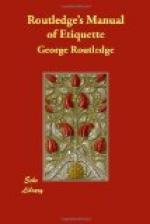Legal Settlements.
These are matters that must be attended to where there is property on either side; and it behoves the intending bridegroom to take care there is no unnecessary delay in completing them. An occasional morning call in one of the Inns of Court at this period is often found to be necessary to hasten the usually sluggish pace of the legal fraternity. On the business part of this matter it is not the province of our work to dilate; but we may be permitted to suggest that two-thirds, or at least one-half, of the lady’s property should be settled on herself and offspring; and that where the bridegroom has no property wherewith to endow his wife, and has solely to rely on his professional prospects, it should be made a sine qua non that he should insure his life in her favour previously to marriage.
How to be Married.
By this time the gentleman will have made up his mind in what form he will be married—a question, the solution of which, however, must chiefly depend on his means and position in life. He has his choice whether he will be married by BANNS, by LICENCE, by SPECIAL LICENCE, or before the Registrar; but woe betide the unlucky wight who should venture to suggest the last method to a young lady or her parents!
Marriage by Banns.
For this purpose, notice must be given to the clerk of the parish or of the district church. The names of the two parties must be written down in full, with their conditions, and the parishes in which they reside—as, “Between A B, of the parish of St. George, bachelor (or widower, as the case may be), and C D, of the parish of St. George, spinster (or widow, as the case may be).” No mention of either the lady’s or gentleman’s age is required. Where the lady and gentleman are of different parishes, the banns must be published in each, and a certificate of their publication in the one furnished to the clergyman who may marry the parties in the church of the other parish.
It seems singular, albeit it is the fact, that no evidence of consent by either party is necessary to this “putting up of the banns,” as is it denominated; indeed, the publication of the banns is not unfrequently the first rural declaration of attachment, so that the blushing village maiden sometimes finds herself announced as a bride-elect before she has received any actual declaration. The clerk receives his fee of two shillings and makes no further inquiries; nay, more, is prepared, if required, to provide the necessary fathers on each side, in the respectable persons of himself and the sexton—the venerable pew-opener being also ready, on a pinch, to “perform” the part of bridesmaid.




